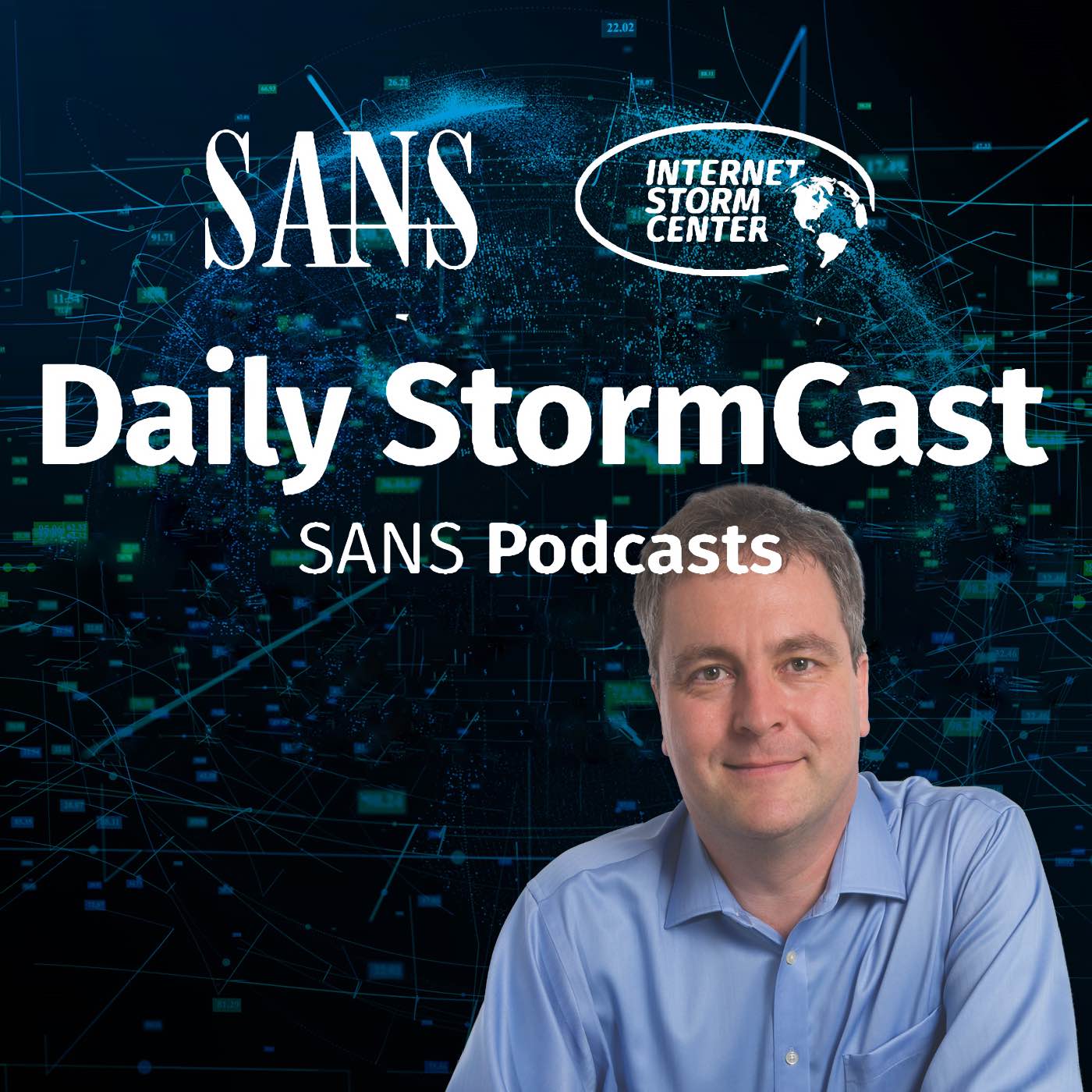Handler on Duty: Brad Duncan
Threat Level: green
Podcast Detail
SANS Stormcast Tuesday, May 6th: Mirai Exploiting Samsung magicInfo 9; Kali Signing Key Lost;
If you are not able to play the podcast using the player below: Use this direct link to the audio file: https://traffic.libsyn.com/securitypodcast/9438.mp3
My Next Class
| Network Monitoring and Threat Detection In-Depth | Online | Central European Time | Dec 15th - Dec 20th 2025 |
| Application Security: Securing Web Apps, APIs, and Microservices | Orlando | Mar 29th - Apr 3rd 2026 |
Mirai Now Exploits Samsung MagicINFO CMS CVE-2024-7399
The Mirai botnet added a new vulnerability to its arsenal. This vulnerability, a file upload and remote code execution vulnerability in Samsung’s MagicInfo 9 CMS, was patched last August but attracted new attention last week after being mostly ignored so far.
https://isc.sans.edu/diary/Mirai+Now+Exploits+Samsung+MagicINFO+CMS+CVE20247399/31920
New Kali Linux Signing Key
The Kali Linux maintainers lost access to the secret key used to sign packages. Users must install a new key that will be used going forward.
https://www.kali.org/blog/new-kali-archive-signing-key/
The Risk of Default Configuration: How Out-of-the-Box Helm Charts Can Breach Your Cluster
Many out-of-the-box Helm charts for Kubernetes applications deploy vulnerable configurations with exposed ports and no authentication
https://techcommunity.microsoft.com/blog/microsoftdefendercloudblog/the-risk-of-default-configuration-how-out-of-the-box-helm-charts-can-breach-your/4409560
Discussion
New Discussions closed for all Podcasts older than two(2) weeks
Please send your comments to our Contact Form
| Network Monitoring and Threat Detection In-Depth | Online | Central European Time | Dec 15th - Dec 20th 2025 |
| Application Security: Securing Web Apps, APIs, and Microservices | Orlando | Mar 29th - Apr 3rd 2026 |
| Network Monitoring and Threat Detection In-Depth | Amsterdam | Apr 20th - Apr 25th 2026 |
| Application Security: Securing Web Apps, APIs, and Microservices | San Diego | May 11th - May 16th 2026 |
| Network Monitoring and Threat Detection In-Depth | Online | Arabian Standard Time | Jun 20th - Jun 25th 2026 |
| Network Monitoring and Threat Detection In-Depth | Riyadh | Jun 20th - Jun 25th 2026 |
| Application Security: Securing Web Apps, APIs, and Microservices | Washington | Jul 13th - Jul 18th 2026 |
Podcast Transcript
Hello and welcome to the Tuesday, May 6, 2025 edition of the SANS and Night Storm Center's Stormcast. My name is Johannes Ulrich and today I am recording from San Diego, California. In diaries today, well, I saw some initial attacks against Samsung's Magic Info CMS. This is a somewhat defunct, not quite a really sort of maintained piece of software anymore. But last August Samsung did release a patch for it, fixing an arbitrary file upload vulnerability that then can lead to remote code execution. This particular vulnerability was not really noticed much, part probably because of the very sort of short sort of one -liner that Samsung published about it. Last week, Cybersecurity Info did cite some research reports. Sadly, I didn't see a link to the actual research report or any more attribution to it. But this particular article about the research report did quote it, noting a particular URL that's being used to upload these files and then also some additional details about the vulnerability. Well, a couple days later, we started seeing some actual exploit attempts. These exploit attempts appear to be coming from what's sort of often described still as Mirai, basically a botnet that does exploit various vulnerabilities, often of course IoT style vulnerabilities. This I would definitely not necessarily sort of call an IoT style vulnerability. It is more a server component used to basically manage content. That's what CMS content management servers are doing. Not really sure how successful these exploit are, but they sort of follow very much the standard pattern where the initial upload uses a number of different ways like TFTP, WGET, CURL, FTP and such to download the second stage. The second stage is then the typical shell script that lists the next download that attempts to download the actual Mirai bot for various architectures. Actually, very extensive list in this particular version. And then, well, they basically just trial and run and whatever version they get to run. Well, then try to find additional victims. It's very well recognized by VirusTotal, so definitely not a new threat. I'm obviously a bit careful characterizing stuff like this, Cilis Mirai. Yes, they probably still share some of the original Mirai code, but that has been worked on, changed, updated so many times now. So many vulnerabilities have been added by various actors to be exploited by these botnets. But ultimately, they still don't really do anything different than the original Mirai bot. Anyway, if you're running any of these Samsung match again for nine CMSs. So make sure they're patched. Like I said, the patch was released last August, but not really advertised much. So it may be easy to miss this particular patch. And if you're a user of Kali Linux, be aware that Kali Linux lost access to their original signing key. What this means is that they had to create a new signing key for any packages used by Kali Linux. And as a result, well, you may get some signature verification failures if you're trying to update Kali Linux. They don't specify how or why the key was lost. It could be as easy as them, well, basically losing a hard drive. The key was stored on not having a proper backup. They specifically state that the key was not compromised. So any packages that you have from before the key was lost that are signed by this original key should still be considered trusted. But the problem is since basically the key was lost before they were able to push a new replacement key, you now have to do so manually and manually mark that key as trusted, that new key in order to validate any future packages. This is mostly a problem if you're automatically updating your system. One possible solution that they recommend is just to rebuild the system from scratch. If you're downloading Kali Linux now from the official website, well, you'll get the new keys already preinstalled on the image. Not a great thing to happen. But well, stuff happens. And good reminder to always keep multiple backups and if possible, also just a simple printed copy of any key keys for critical issues like this. And researchers at Microsoft published a blog warning of default configurations commonly deployed in popular Kubernetes Helm charts. Helm is a packet manager for Kubernetes. And Helm charts are essentially scripts that you're using to deploy applications. So all the necessary packages are being installed and the application is completely installed and configured in your Kubernetes cluster. But as so often, many of the default settings in these Helm charts aren't necessarily appropriate. In particular, they're exposing ports. They're not necessarily configuring the system securely, including often missing passwords. If you are using Helm charts, definitely read the article, and then read the article. And you'll be aware of some of these issues. So you can then fix up the configurations and make sure that they are secure. Well, that's it for today in San Diego on Tuesday evening. I'll actually give a talk about some of the developer supply chain risks. If you happen to be here at the event, welcome to attend. If you just happen to be in the area, send me a message if you're interested. I may be able to get a couple of people in here. So that's it for today and talk to you again tomorrow. Bye.











